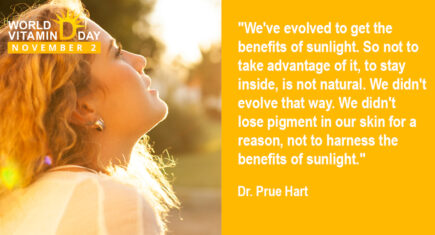November Means No Vitamin D from Sunshine—Here’s Your Action Plan

TORONTO, ON (October 29, 2025) – Vitamin D winter has begun. The sun’s UVB rays reaching earth in northern latitudes is now too weak to initiate vitamin D production in your skin. The Vitamin D Society through the 17th annual November Vitamin D Awareness Month and World Vitamin D Day on November 2nd is urging everyone to TAKE ACTION to prevent vitamin D deficiency this winter.
Historically, 90% of our vitamin D came from sunshine exposure. Sunshine contains UVB and this is what initiates vitamin D production through your skin. UVB rays are a short ray and need to be directly overhead to penetrate the earth’s atmosphere. The best time to produce vitamin D is in the summer from 10am to 2pm when the sun is directly overhead. Your shadow needs to be shorter than your height and the UV index needs to be above 3.
In November, the northern hemisphere tilts away from the sun and the suns path is much lower in the sky. Shadows become longer. Research studies have shown that at latitudes above 37°N sunlight is insufficient to make vitamin D in your skin during the winter months.
Take action to make sure you are not vitamin D deficient this winter:
1. Adults need a daily vitamin D intake of 4,000 IU/day (100 mcg) from all sources, according to levels recommended by vitamin D experts.
2. Get out in the natural sunlight when the UV Index is above 3 and your shadow is shorter than your height. Remember to never sunburn.
3. Consider artificial UVB exposure when natural sunlight is weak or not available and your skin type can receive UV exposure without burning.
4. Increase your food intake of fatty fish such as salmon.
5. Take a vitamin D3 supplement to make up the balance when sun exposure is not available or a viable option. UVB from sunlight or a sunlamp is what makes vitamin D naturally in your skin. Remember vitamin D supplements don’t replace all the benefits you get from sunlight. There are so many more photoproducts that sunlight creates in your skin, like nitric oxide for cardiovascular health.
6. Test and make sure your 25(OH)D blood level is between 100-150 nmol/L (Canada) or 40-60 ng/ml (USA). (home-based test)
Perry Holman, Executive Director of the Vitamin D Society states: “Researchers are finding new benefits of sunlight that play a major role in reducing disease and supporting a longer, healthier life. The benefits of not getting enough sunlight far outweigh the risks. Make sure you do not sunburn.”
Dr. Prue Hart an expert researcher studying immunology reports: “There is more multiple sclerosis in populations living further from the equator. Evidence suggests that lack of sun exposure, and particularly low levels of vitamin D and other molecules made in skin upon sun exposure, are responsible.”
Our good friends at GrassrootsHealth have some exciting news to share. This Vitamin D Day, on November 2nd, GrassrootsHealth will be announcing their new Vitamin D Scientists’ Award Fund and annual award event, along with weekly “Vitamin D Study Hour” webinars featuring the world’s leading vitamin D researchers and experts. Be sure to sign up for their free weekly newsletters to keep on top of all the latest vitamin D research and upcoming webinars.
For more information on World Vitamin D Day on November 2nd, please visit our website and help take action to STOP vitamin D deficiency. To help us inform Canadians, please consider sharing one of our graphics from the Tools section on social media on November 2nd and throughout November. Thank you!
Please help STOP Vitamin D Deficiency!
About the Vitamin D Society:
The Vitamin D Society is a Canadian non-profit group organized to increase awareness of the many health conditions strongly linked to vitamin D deficiency; encourage people to be proactive in protecting their health and have their vitamin D levels tested annually; and help fund valuable vitamin D research. The Vitamin D Society recommends people achieve and maintain optimal 25(OH)D blood levels between 100 – 150 nmol/L (Can) or 40-60 ng/ml (USA).
To learn more about vitamin D, please visit www.vitamindsociety.org
SmartTan.com news articles regularly report medical and scientific information to keep you abreast of current events related to UV light. This information is not intended to be used by any party to make unwarranted health claims to promote sunbed usage. Indoor tanning businesses are obligated to communicate a fair and balanced message to all clients about your products and services including the potential risks associated with indoor tanning. Contact your Smart Tan representative to find out more about what you can and can’t say in your tanning salon business.
© 2025 International Smart Tan Network. All rights reserved.
